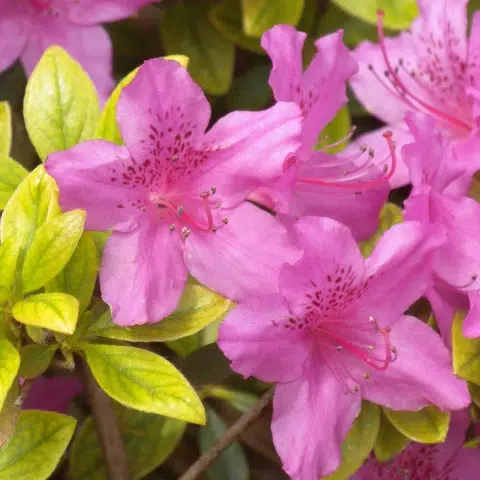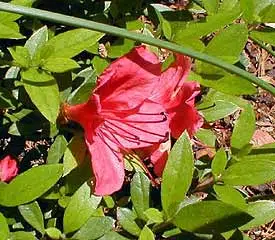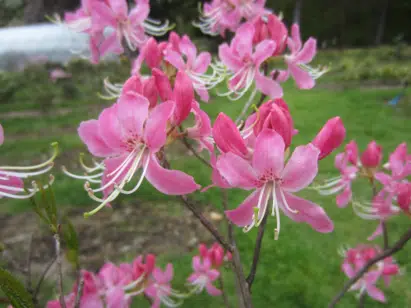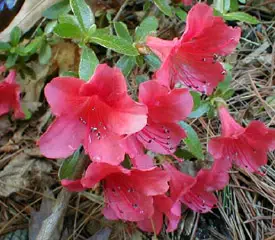Plants

Looking for something in particular? Click here to search.

Geranium sanguineum v. striatum
Geranium sanguineum v. striatum (bloody cranesbill)
Bloody cranesbill is an herbaceous, clump-forming perennial that typically grows in a mound with white-hairy trailing stems which spread over time to as much as 24” wide. While it is native to Europe and Asia, it... more

Fothergilla ‘Mt. Airy’ (dwarf fothergilla)
Dwarf fothergilla is a deciduous shrub with great fall color and fragrant flowers. It prefers acidic soils with high organic matter that are consistently moist but with good drainage. Flowers best in full sun... more

Deutzia ‘Nikko Blush’
Deutzia ‘Nikko Blush’ (deutzia)
This new hybrid from the National Arboretum welcomes spring with a profusion of soft pink blooms. It has a compact, low-growing form perfect for a foundation planting or low hedge. Deciduous green... more

Callicarpa b. ‘Profusion’
Callicarpa b. ‘Profusion’ (beautyberry)
Callicarpa bodinieri ‘Profusion’ features an outstanding display of violet-purple fruits in fall. Forms a vigorous bushy shrub with small lavender flowers in July and August. New leaf growth has a bronze tinge. Easily grown in sun or... more

Bergenia ‘Winterglut’
Bergenia ‘Winterglut’ (pigsqueak)
Pig squeak, named because of the noise produced by rubbing a leaf between thumb and finger, is a clump-forming perennial which is primarily grown as a ground cover and features large rosettes... more

Athyrium niponicum var. pictum
Athyrium niponicum var. pictum (Japanese painted fern)
One of the easiest and most rewarding hardy ferns, this selection performs well in any rich, evenly moist soil. It forms a compact clump of fronds, dark green in colour, overlaid in olive and silvery-pewter, with contrasting... more

Athyrium otophorum
Athyrium otophorum (eared lady fern)
Athyrium otophorum, commonly called eared lady fern, is a deciduous, Asian woodland species which typically grows to 18" tall and features erect, triangular, dusky green fronds with dark burgundy stems. Young pale green fronds emerge throughout the growing... more

Astilbe ‘Deutschland’
Astilbe ‘Deutschland’ (astilbe)
Plants are characterized by graceful, fern-like mounds of mostly basal leaves. Plumes of snow white, feathery flowers create a very showy landscape accent in moist areas in a shaded to dappled shade setting. ‘Deutschland’, a hybrid cultivar of Japanese... more

Acanthus spinosus
Acanthus spinosus (bear’s breeches)
Acanthus spinosus has shiny dark green leaves which are deeply dissected and tipped with spines (hence deer resistant). The handsome foliage adds great coarse texture to a partial shaded garden. Features pure white, snapdragon-like flowers surrounded by contrasting spiny purple bracts that last all season. Large flower spikes... more

Zizia aurea
Golden Alexander
Golden Alexander is a member of the carrot family and is easy to grow. Although short-lived, it will self-seed and adapt to a variety of soil and light conditions. It has persisted in the Wildflower Garden in full shade for many years but is much... more

Vaccinium macrocarpon
Large cranberry
Large cranberry is a creeping shrub with small alternate oval leaves. The delicate pink to white flower petals recurve to form a Turk’s cap and bloom in mid to late... more

Thelypteris palustris
Marsh fern
This perennial fern has upright compound leaves whose leaflets are often slightly curved and twisted. The root system is rhizomatous and fibrous and can form dense colonies and performs as a wonderfully as a ground cover. Marsh fern... more

Tiarella 'Brandywine'
Foamflower
Foamflower is a vigorous running ground cover, sometimes with red speckled foliage and plenty of white flower spikes. This plant will create a wonderful blanket quickly when given moist soil high in organic... more

Stylophorum diphyllum
Wood poppy
Also known as celandine poppy, in the spring, this plant yields mounds of bright yellow flowers in the woodland. All your neighbors will ask ‘What’s that beautiful yellow flower?”. A small pair of leaves... more

Sedum ternatum 'Larinem Park'
Wild stonecrop
A sedum for shade! Yup, this Sedum is a beautiful low-growing groundcover for the shady garden, covered with flowers in masses of small white stars in the early spring. This plant usually grows... more

Evergreen azalea ‘Compacta’
A long name for a short plant. The Korean azalea, Rhododendron yedoense, is one of the main sources of cold hardiness for the evergreen azaleas grown in our area. ‘Compacta’ is a dwarf selection of the otherwise large-growing species. Lavender flowers are produced... more

Rhododendron ‘Wintergreen’
Evergreen azalea ‘Wintergreen’
Polly Hill was an exceptional plantswoman from Martha’s Vineyard. Many of Polly’s azaleas are interspecific hybrids involving an incredibly compact azalea from Taiwan called Rhododendron nakaharae. ‘Wintergreen’ has light red blooms mid-June into... more

Rhododendron vaseyi ‘Spring Spangle’
Deciduous azalea ‘Spring Spangle’
This is a deciduous azalea that produces clusters of pink flowers in mid-spring and has wonderful red-purple fall color. Can take sun or shade. An excellent azalea for our area. Only... more

Rhododendron ‘Susannah Hill’
Evergreen azalea ‘Susannah Hill’
Polly Hill was an exceptional plantswoman from Martha’s Vineyard. Many of Polly’s azaleas are interspecific hybrids involving an incredibly compact azalea from Taiwan called Rhododendron nakaharae. ‘Susannah Hill’ is another groundcover azalea... more

Rhododendron ‘Pink Pancake’
Evergreen azalea ‘Pink Pancake’
Polly Hill was an exceptional plantswoman from Martha’s Vineyard. Many of Polly’s azaleas are interspecific hybrids involving an incredibly compact azalea from Taiwan called Rhododendron nakaharae. ‘Pink Pancake’ is a flat grower,... more

Rhododendron ‘Mangetsu’
Evergreen azalea ‘Mangetsu’
A mounding, dwarf azalea selection. This cultivar, and another (‘Komo Kulshan’), is often attributed to a Japanese species called the Kyushu azalea, Rhododendron kiusianum. But azaleas are promiscuous, and this may be a hybrid. Flowers are white with purple... more

Rhododendron ‘Komo Kulshan’
Evergreen azalea ‘Komo Kulshan’
A favorite of the staff at the David G. Leach Research Station. This cultivar, and another offered this year (‘Mangetsu’), is often attributed to a Japanese species called the Kyushu azalea, Rhododendron kiusianum. But azaleas... more

Rhododendron ’Joseph Hill’
Evergreen azalea ’Joseph Hill’
Polly Hill was an exceptional plantswoman from Martha’s Vineyard. Many of Polly’s azaleas are interspecific hybrids involving an incredibly compact azalea from Taiwan called Rhododendron nakaharae. ‘Joseph Hill’ is a trailing, red-flowered evergreen shrub that makes an excellent... more

Rhododendron ‘Bowie’
Lepidote rhododendron
'Bowie’, pronounced like “buoy”, is an intraspecific hybrid, scaly-leaved rhododendron, meaning it is the result of crossing the Appalachian native Rhododendron minus with the Florida Panhandle endemic Rhododendron minus var. chapmanii. Flip the leaves over and you’ll see tiny scales across the surface. A good... more
People for Trees™
Make a difference in
your own backyard.
Plant and care for a tree beginning with making a pledge. We will support each pledge with easy-to-follow instructional toolkits, guidance on how to select the most appropriate tree and where to purchase it, free virtual classes and other ongoing support.
Make a pledgeWhat can we help you find?
Popular searches:




